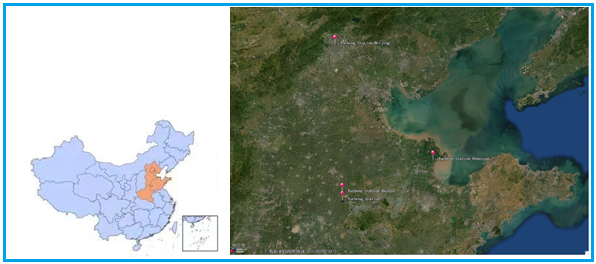The Yucheng Comprehensive Experiment Station (Yucheng Station) of the Chinese Academy of Sciences (CAS) (Shandong Yucheng Agro-ecosystem National Observation and Research Station, SYA-NORS ) was formally established in 1979 under the auspices of the Institute of Geographic Sciences and Natural Resources Research, Chinese Academy of Sciences (IGSNRR-CAS), became an experiment station for agro-ecosystems of the Chinese Ecosystem Research Network (CERN) in 1992, entered the first batch of national stations as a pilot station in 1999, and officially became a national station in 2006. With the strong support from the Ministry of Science and Technology (MOST), IGSNRR, and CAS, the station has made great development over the past 40 years. It rated excellent (8/97) in the evaluation of the national field station organized by the MOST in 2019.

Location of Yucheng Station
Yucheng Station has four locations, headquarter in Beijing, main station and farm in Yucheng, and Dongying center in Shandong Province. Located in Yucheng City, Shandong Province, Yucheng Station (36°50′ N, 116°34′ E, about 17.5‒26.1 a.s.l.m), representing typical agricultural management systems in the Huanghuaihai Plain (means Yellow River or Huanghe, Huai River, and Hai River, HHH Plain) or even North China Plain (NCP). This region has a semi-humid monsoon climate with an average annual temperature of 14.7°C and a mean annual precipitation of 623.7 mm with most of the rainfall occurring between June to September. The annual evaporation is about 950 mm, with total solar radiation of 5225 MJ/m2 and sunshine duration of 2640 hours. The accumulated temperature higher than 0℃ is 4951℃ with frost-free period of 200 days. The groundwater level is generally 1.5-7.0 meters. The soil dominates by calcaric fluvisol with a silt loam surface texture (13% sand, 65% silt, and 22% clay). The main properties (0–20 cm depth) of soils are as follows: pH, 8.30; total organic matter, 12.6 g kg-1; total (nitrogen) N, 0.89 g kg-1; total (phosphorus) P, 2.11 g kg-1; total (potassium) K, 21.4 g kg-1; and soil bulk density, 1.27 g cm-3. The agro-ecosystem is dominated by wheat-corn rotation.